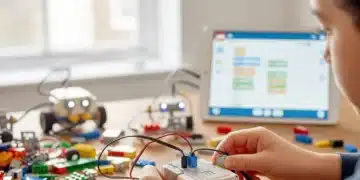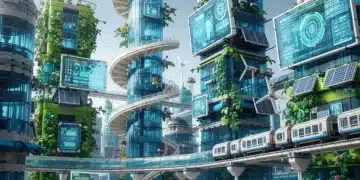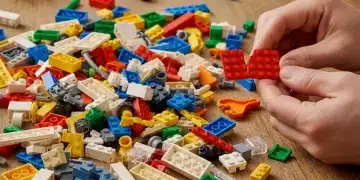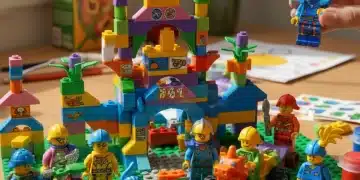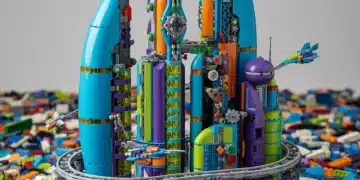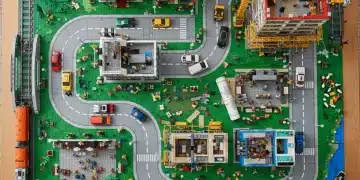Lego Education: Using Bricks to Teach STEM Concepts Effectively

Advertisements
Lego Education provides an innovative, hands-on approach using building bricks to effectively teach science, technology, engineering, and mathematics (STEM) concepts, fostering critical thinking and collaborative problem-solving skills in young learners.
Have you ever wondered how simple plastic bricks could unlock the complex world of science, technology, engineering, and mathematics? Lego Education: Using Bricks to Teach STEM Concepts is transforming how children learn, moving beyond textbooks to engage young minds in a tangible, interactive way. This approach makes abstract ideas concrete, encouraging creativity, collaboration, and a deep understanding of core principles.
Anúncios
The foundation of Lego Education in STEM
Lego Education is not just about playing with bricks; it’s about structured learning experiences designed to introduce and reinforce critical STEM concepts. By providing specialized kits and curriculum materials, Lego Education offers educators and parents a powerful tool to engage children in design, construction, and problem-solving. This hands-on methodology allows kids to experiment, make mistakes, and learn from them in a safe and supportive environment.
The core philosophy behind Lego Education’s approach to STEM is rooted in active learning. Children are not passive recipients of information; instead, they are active participants in their educational journey. They build, test, and refine their creations, directly applying scientific principles, technological understanding, engineering design processes, and mathematical reasoning. This experiential learning fosters a deeper comprehension and retention of complex subjects.
Anúncios
Bridging theory and practice
One of the most significant benefits of Lego Education is its ability to bridge the gap between theoretical knowledge and practical application. Students learn about forces, motion, gears, and programming by building models that demonstrate these concepts in action. This tangible connection helps solidify their understanding and makes learning more meaningful.
- Kinesthetic Learning: Engaging hands-on activities cater to kinesthetic learners, who grasp concepts best through physical interaction.
- Problem-Solving: Challenges embedded in the curriculum require students to identify problems, brainstorm solutions, and implement them.
- Critical Thinking: Students must analyze situations, evaluate their designs, and make informed decisions to improve their models.
- Creativity and Innovation: The open-ended nature of Lego building encourages imaginative solutions and original designs.
Ultimately, Lego Education transforms the classroom into a dynamic workshop where curiosity is celebrated and exploration is encouraged. It empowers children to become innovators and thinkers, preparing them for a future where STEM skills are increasingly vital. The program’s success lies in its ability to make learning fun and accessible, demystifying subjects that might otherwise seem intimidating.
Exploring engineering principles with Lego bricks
Engineering is at the heart of much of what Lego Education offers. Children learn fundamental engineering principles by designing, building, and testing structures, machines, and robots. They grapple with concepts like stability, balance, leverage, and structural integrity, often without even realizing they are engaging in advanced engineering thought processes.
From simple machines to complex robotic systems, Lego bricks provide a versatile medium for engineering exploration. Students can construct bridges that withstand varying loads, build vehicles that move efficiently, or design mechanisms that perform specific tasks. Each project presents a unique engineering challenge, requiring them to think systematically and apply their knowledge to real-world scenarios.
Design and iterative improvement
A crucial aspect of engineering is the iterative design process, and Lego Education perfectly facilitates this. Students learn that their first design might not be perfect, and that’s okay. They are encouraged to test their models, identify flaws, and make improvements. This process of continuous refinement teaches resilience, adaptability, and the importance of perseverance in problem-solving.
- Structural Design: Building towers, bridges, and other structures helps students understand load-bearing, stress distribution, and architectural stability.
- Mechanical Engineering: Exploring gears, levers, pulleys, and wheels teaches principles of force, motion, and energy transfer.
- Robotics Fundamentals: Constructing and programming simple robots introduces basic concepts of automation, sensors, and actuators.
- Systems Thinking: Students learn how different components work together to form a functional system, understanding the interdependencies.
Through these hands-on activities, children develop an intuitive understanding of how things work and why certain designs are more effective than others. They learn the value of planning, execution, and critical evaluation, skills that are transferable across all academic disciplines and future careers. Lego Education makes engineering accessible and exciting, turning abstract theories into concrete achievements.
The role of technology and coding in Lego Education
In today’s digital age, technology and coding are indispensable skills, and Lego Education integrates these concepts seamlessly into its curriculum. With kits like Lego Mindstorms and Spike Prime, children are introduced to the fundamentals of programming, computational thinking, and robotics. They learn to give instructions to a machine, observe its response, and debug their code, developing crucial digital literacy.
This exposure to coding goes beyond simple block-based programming; it teaches logical sequencing, conditional statements, loops, and variables. Students program robots to navigate mazes, pick up objects, or respond to environmental stimuli. This interactive approach demystifies coding, making it an engaging and creative endeavor rather than a daunting technical task.
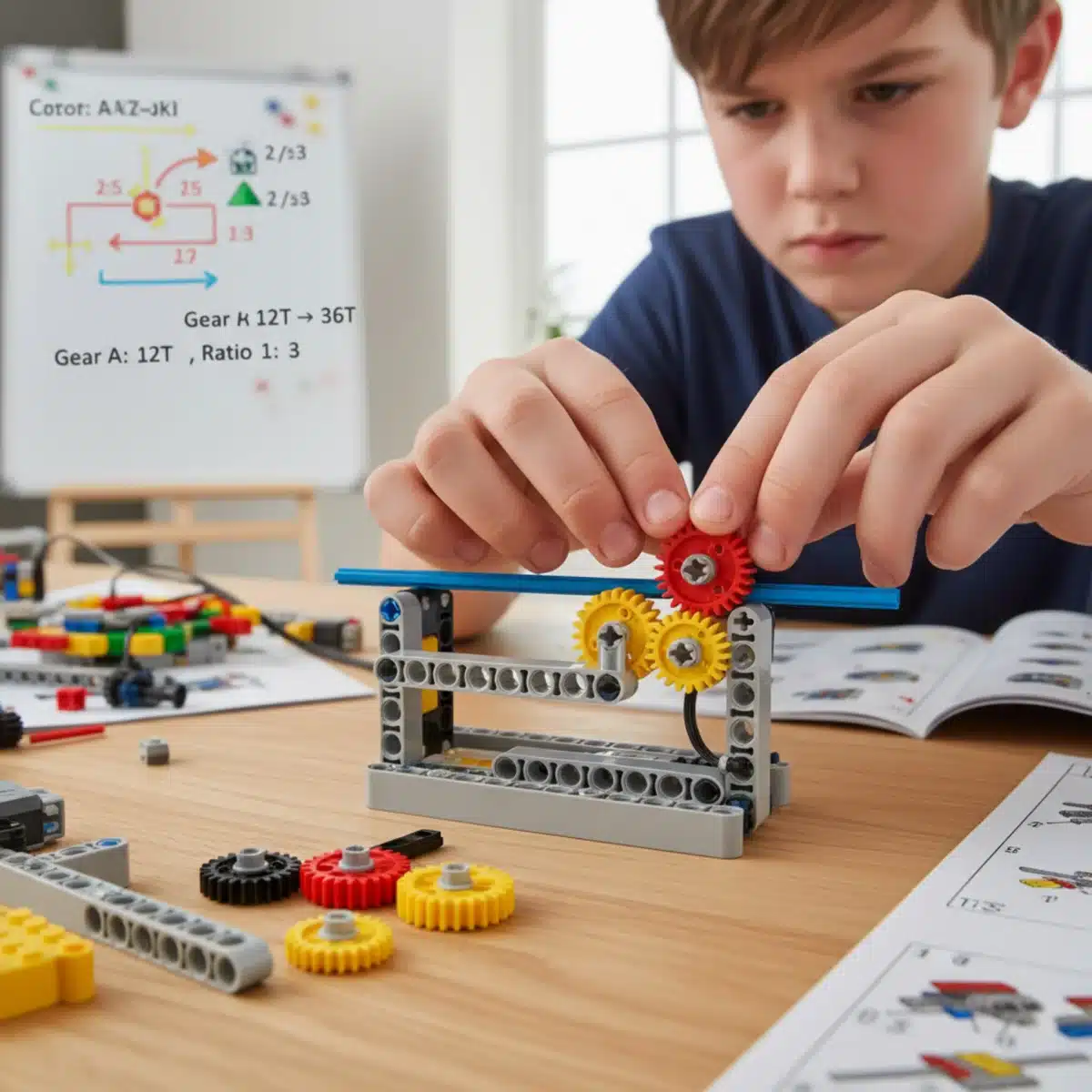
Developing computational thinking
Computational thinking is a problem-solving process that involves breaking down complex problems into smaller, more manageable parts, recognizing patterns, abstracting details, and designing algorithms. Lego Education activities inherently foster these skills. When students program a robot, they must analyze the desired outcome, sequence the necessary steps, and anticipate potential issues.
- Algorithmic Thinking: Students create step-by-step instructions (algorithms) for their robots to follow.
- Pattern Recognition: They identify recurring patterns in problems and apply existing solutions or create new ones.
- Abstraction: Focusing on essential information while ignoring irrelevant details to solve a problem effectively.
- Debugging Skills: Learning to identify and correct errors in their code, a vital skill for any programmer.
The immediate feedback provided by the physical robot allows children to see the direct consequences of their code, fostering a deeper understanding of cause and effect in programming. This hands-on debugging process is incredibly effective for learning. By making technology tangible and interactive, Lego Education prepares children not just to use technology, but to understand, create, and innovate with it.
Integrating mathematics and scientific inquiry
Mathematics forms the bedrock of all STEM disciplines, and Lego Education provides numerous opportunities to apply mathematical concepts in practical contexts. Whether it’s measuring distances, calculating gear ratios, understanding angles, or analyzing data from sensor readings, math is an integral part of the building and programming process. This contextual learning makes mathematics relevant and engaging for students.
Similarly, scientific inquiry is naturally woven into Lego Education activities. Children are encouraged to ask questions, formulate hypotheses, conduct experiments, observe results, and draw conclusions. They learn to collect and interpret data, identify variables, and understand the scientific method through direct experience, making science less abstract and more about discovery.
Hands-on data analysis and measurement
When building a car, students might measure the distance it travels with different wheel sizes or motor speeds, collecting data and graphing their findings. When designing a structure, they might calculate the forces acting upon it. These practical applications of math go far beyond rote memorization, fostering a deeper, more intuitive understanding of numerical relationships and spatial reasoning.
- Measurement and Geometry: Activities involve measuring lengths, angles, and volumes, and understanding geometric shapes and their properties.
- Data Collection and Analysis: Students gather data from experiments (e.g., robot speed, sensor readings) and learn to represent and interpret it.
- Proportions and Ratios: Exploring gear ratios and pulley systems provides practical experience with proportional reasoning.
- Problem-Solving with Math: Applying mathematical formulas and logic to solve engineering and robotics challenges.
Through scientific inquiry, children develop critical observation skills and learn to think like scientists. They understand that science is not just a collection of facts, but a process of exploration and discovery. Lego Education empowers them to conduct their own investigations, fostering a lifelong love for scientific exploration and mathematical understanding.
Benefits of collaborative learning with Lego Education
Beyond individual skill development, Lego Education strongly emphasizes collaborative learning. Most activities are designed for small groups, encouraging students to work together, share ideas, and collectively solve problems. This team-based approach is crucial for developing essential social and communication skills that are vital in both academic and professional settings.
When children collaborate on a Lego project, they learn to delegate tasks, listen to different perspectives, negotiate solutions, and compromise. They experience the power of collective intelligence, understanding that diverse viewpoints can lead to more innovative and robust solutions. This collaborative environment also builds confidence and fosters a sense of shared accomplishment.

Developing essential social skills
Working in teams on complex projects helps children develop empathy and understanding for others’ ideas. They learn to articulate their thoughts clearly and to respectfully challenge or support the ideas of their peers. These interactions are fundamental for building strong interpersonal relationships and effective team dynamics.
- Communication: Students must clearly explain their ideas, listen to others, and provide constructive feedback.
- Teamwork: Learning to divide tasks, cooperate, and support group members to achieve a common goal.
- Conflict Resolution: Navigating disagreements and finding mutually acceptable solutions during group work.
- Leadership and Followership: Opportunities arise for students to take initiative and to follow the lead of others.
The collaborative nature of Lego Education projects mirrors the real-world environments of scientific research and engineering teams. By experiencing these dynamics early on, children are better prepared for future projects and careers that demand strong teamwork and communication. It transforms learning into a shared adventure, where everyone contributes to success.
Future-proofing education with Lego STEM
As the world rapidly evolves, the demand for individuals proficient in STEM fields continues to grow. Lego Education plays a pivotal role in future-proofing education by equipping children with the foundational skills and mindset necessary to thrive in an innovation-driven society. It nurtures not just technical abilities but also critical thinking, creativity, and adaptability – qualities essential for navigating future challenges.
By making STEM accessible and exciting from an early age, Lego Education helps to spark a lifelong interest in these crucial subjects. It encourages children to see themselves as scientists, engineers, and innovators, breaking down preconceived notions about who can excel in STEM. This early engagement is vital for building a diverse and skilled workforce for tomorrow.
Inspiring the next generation of innovators
The playful yet structured environment of Lego Education empowers children to explore, experiment, and invent without fear of failure. It cultivates a growth mindset, where challenges are seen as opportunities for learning and improvement. This approach is fundamental for fostering the resilience and curiosity required to push the boundaries of knowledge and technology.
- Career Readiness: Provides early exposure to STEM concepts and careers, helping students explore potential pathways.
- Adaptability: Encourages flexible thinking and problem-solving skills, preparing students for an unpredictable future.
- Innovation Mindset: Fosters creativity and the ability to think outside the box to develop novel solutions.
- Global Competence: Develops skills that are universally valued in a globalized, technologically advanced world.
Ultimately, Lego Education is more than just a teaching tool; it’s a catalyst for change in education. It demonstrates that learning can be joyful, deeply engaging, and profoundly impactful. By investing in hands-on STEM education with Lego, we are investing in the future capabilities and potential of our children, preparing them to build a better world, one brick at a time.
| Key Aspect | Brief Description |
|---|---|
| Hands-on Learning | Engaging children through physical building and experimentation for deeper STEM comprehension. |
| Engineering Principles | Teaching design, structure, and mechanics through building and testing models. |
| Coding & Robotics | Introducing programming logic and computational thinking with interactive robots. |
| Collaborative Skills | Fostering teamwork, communication, and problem-solving through group projects. |
Frequently Asked Questions about Lego Education STEM
Lego Education offers a range of kits and curricula designed for various age groups, typically starting from pre-school (3-6 years old) all the way up to middle school (11-14 years old). Each set is tailored to developmental stages and learning objectives.
While both use Lego bricks, Lego Education kits are specifically designed with educational goals in mind, often including specialized components, structured lesson plans, and curriculum-aligned activities focused on STEM concepts. Regular Lego sets are primarily for free play.
While widely adopted in educational institutions, many Lego Education kits and resources are also suitable for home learning environments. Parents can purchase kits and access online resources to facilitate engaging STEM learning experiences for their children outside of school.
Lego Education focuses on developing critical thinking, problem-solving, creativity, collaboration, computational thinking, and engineering design skills. It covers concepts in physics, mechanics, robotics, programming, data analysis, and mathematics through practical application.
Lego Education utilizes intuitive, block-based coding interfaces that are designed to be accessible and engaging for young learners. This visual programming approach simplifies complex logic, allowing children to grasp coding fundamentals without needing to learn complex syntax.
Conclusion
Lego Education represents a pioneering and highly effective approach to teaching STEM concepts, transforming abstract theories into tangible, engaging experiences. By leveraging the inherent appeal of Lego bricks, it empowers children to explore, design, build, and innovate, fostering a deep understanding of science, technology, engineering, and mathematics. This hands-on methodology not only enhances academic performance but also cultivates essential 21st-century skills such as critical thinking, problem-solving, collaboration, and creativity. As we look to prepare the next generation for an increasingly complex world, Lego Education stands out as a powerful tool, inspiring young minds to become the innovators and problem-solvers of tomorrow, one brick-built solution at a time.
